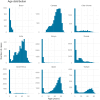Severity Scale of Influenza and Acute Respiratory Illness Hospitalizations to Support Viral Genomic Surveillance: A Global Influenza Hospital Surveillance Network Pilot Study
- PMID: 40045898
- PMCID: PMC11883289
- DOI: 10.1111/irv.70085
Severity Scale of Influenza and Acute Respiratory Illness Hospitalizations to Support Viral Genomic Surveillance: A Global Influenza Hospital Surveillance Network Pilot Study
Abstract
Background: This study aimed to establish a Severity Scale for influenza and other acute respiratory infections (ARI), requiring hospitalization, for surveillance and research purposes (the SevScale). Such a scale could aid the interpretation of data gathered from disparate settings. This could facilitate pooled analyses linking viral genetic sequencing data to clinical severity, bringing insights to inform influenza surveillance and the vaccine strain selection process.
Methods: We used a subset of data from the Global Influenza Hospital Surveillance Network database, including data from different geographical areas and income levels. To quantify the underlying concept of severity, an item response model was developed using 16 indicators of severity related to the hospital stay. Each patient in the dataset was assigned a Severity Score and a Severity Category (low, medium, or high severity). Finally, we compared the model scores across different subgroups.
Results: Data from 9 countries were included, covering between 4 and 11 seasons from 2012 to 2022, with a total of 96,190 ARI hospitalizations. Not for all severity indicators data were available for all included seasons. Subgroups with a high percentage of patients in the high Severity Category included influenza A(H1N1)pdm09, age ≥ 50, lower-middle income countries, and admission since the start of the COVID-19 pandemic.
Conclusions: The initial model successfully highlighted severity disparities across patient subgroups. Repeating this exercise with new, more complete data would allow recalibration and validation of the current model. The SevScale proved to be a promising method to define severity for influenza vaccine strain selection, surveillance, and research.
Keywords: acute respiratory infection; influenza; severity.
© 2025 The Author(s). Influenza and Other Respiratory Viruses published by John Wiley & Sons Ltd.
Conflict of interest statement
Sandra S. Chaves is an employee of Sanofi, but the content of this paper is not representative of the views of their organization. Sandra S. Chaves contributed to the interpretation of results and the writing of the manuscript and report as a member of the Foundation for Influenza Epidemiology. Oana Săndulescu and Anca C. Drăgănescu report being investigators in the DRIVE project that has received support from the EU/EFPIA Innovative Medicines Initiative 2 Joint Undertaking (grant no. 777363) outside the scope of the submitted work and the GIHSN project, which was cofunded by the Foundation for Influenza Epidemiology, France, within the scope of the submitted work. Melissa K. Andrew and Sonia M. Raboni report grants from GSK, Sanofi, Pfizer, and Merck, unrelated to the present study. Marta C. Nunes reports grants from the Sanofi, unrelated to the present study, and personal fees from Pfizer and Sanofi, unrelated to the present study. F. Xavier Lopez‐Labrador reports grants and personal fees from Sanofi, unrelated to the present study. Shelly A. McNeil reports grants from Merck, Pfizer, and GSK unrelated to the present study and personal fees from Pfizer, Moderna, Merck, Sanofi, and GSK, unrelated to the present study. Bronke Boudewijns, Saverio Caini, Marco Del Riccio, Justin R. Ortiz, Joseph S. Bresee, Elena Burtseva, Daouda Coulibaly, Daria M. Danilenko, Kirill Stolyarov, Mine Durusu Tanriover, Heloisa I. G. Giamberardino, Parvaiz A. Koul, Ainara Mira‐Iglesias, Alejandro Orrico‐Sanchez, Nancy A. Otieno, Jorim Ayugi, and Peter Spreeuwenberg report no conflict of interest.
Figures
References
-
- World Health Organization , “Factsheet Seasonal Influenza 2023,” [updated 12‐1‐2023, https://www.who.int/news‐room/fact‐sheets/detail/influenza‐(seasonal).
Publication types
MeSH terms
Grants and funding
LinkOut - more resources
Full Text Sources
Medical



